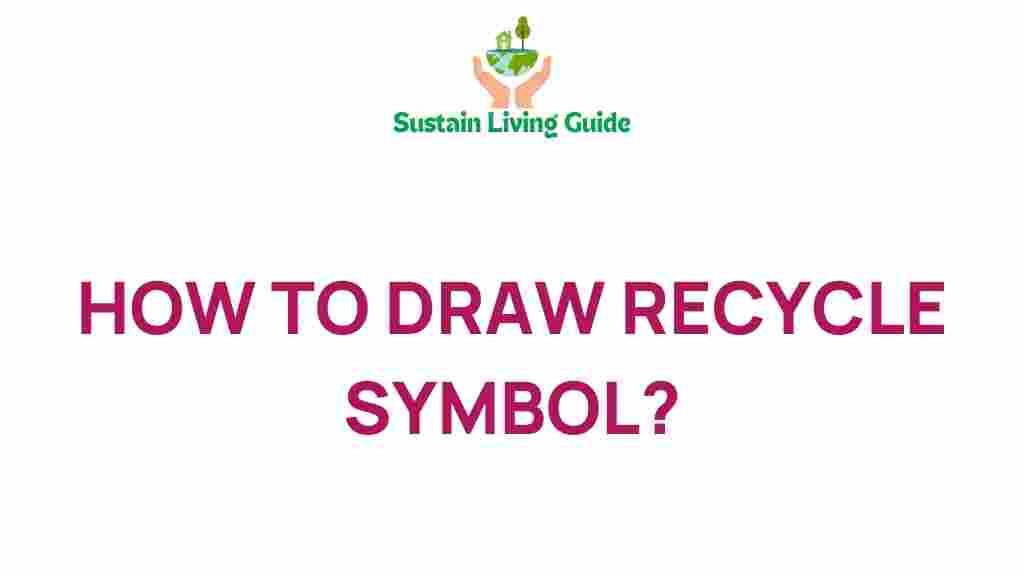Recycle Symbol: Understanding Its Importance and Impact
The recycle symbol is more than just a simple emblem; it’s a powerful representation of sustainability and environmental responsibility. As we dive into the art of the recycle symbol, we’ll explore its origins, significance, and how it inspires individuals to make eco-friendly choices. This creative journey will not only enlighten you about the recycle symbol but also encourage you to embrace recycling as a lifestyle.
The Origins of the Recycle Symbol
The recycle symbol was created in 1970 by a college student named Gary Anderson as part of a design competition hosted by the Container Corporation of America. He aimed to promote the recycling movement that was gaining traction during that time. The symbol itself consists of three arrows forming a continuous triangle, representing the three stages of recycling: collection, processing, and reuse.
Symbol Design and Meaning
The three arrows in the recycle symbol illustrate:
- Collection: The process of gathering recyclables from consumers.
- Processing: Transforming collected materials into new products.
- Reuse: Putting these new products back into circulation to reduce waste.
Understanding this cycle is crucial for promoting sustainability within our communities. By recognizing the recycle symbol, consumers can identify products that can be recycled, helping to minimize landfill waste.
How the Recycle Symbol Influences Consumer Behavior
The recycle symbol plays a significant role in influencing consumer choices and behaviors. Its presence on products serves as a reminder of the importance of recycling, encouraging individuals to think about their waste management practices. Here are some key points on how the recycle symbol impacts consumer behavior:
- Awareness: The symbol raises awareness about recycling and its benefits.
- Trust: Brands that use the recycle symbol often gain consumer trust, as it communicates a commitment to sustainability.
- Behavior Change: Consumers are more likely to recycle products that display the recycle symbol, contributing to a circular economy.
Step-by-Step Guide: How to Properly Recycle
Now that we understand the significance of the recycle symbol, let’s explore how to recycle effectively. Follow these steps to ensure you are doing your part for the environment:
Step 1: Know Your Local Recycling Guidelines
Before you start recycling, familiarize yourself with your local recycling rules. Different areas have specific guidelines for what can and cannot be recycled, so it’s essential to check with your local waste management authority.
Step 2: Clean and Sort Your Recyclables
Before placing items in your recycling bin, make sure to:
- Rinse out containers to remove food residue.
- Sort recyclables according to material type (plastic, paper, metal, glass).
- Remove any non-recyclable components, like lids or caps if required by local guidelines.
Step 3: Find the Recycle Symbol
When shopping or using products, look for the recycle symbol on packaging. This symbol indicates that the item is recyclable. Additionally, check for the recycling code, which provides information about the material’s recyclability.
Step 4: Dispose of Items Properly
Place your sorted and cleaned recyclables in the appropriate recycling bin. Make sure not to mix non-recyclables with recyclables, as this can contaminate the recycling stream and lead to increased landfill waste.
Step 5: Stay Informed and Advocate for Change
Stay updated on recycling initiatives and advocate for better recycling programs in your community. By sharing knowledge about the recycle symbol and its importance, you can inspire others to join the movement.
Troubleshooting Common Recycling Issues
Even with the best intentions, recycling can sometimes be confusing. Here are some common issues you might encounter, along with troubleshooting tips:
Issue 1: Confusion About What Can Be Recycled
If you’re unsure whether an item is recyclable, consult your local recycling guidelines or use online resources to clarify. Many websites provide comprehensive lists of recyclable and non-recyclable materials.
Issue 2: Contamination of Recyclables
Contamination occurs when non-recyclable items are placed in the recycling bin. To avoid this:
- Always rinse containers before recycling.
- Double-check items against local recycling rules.
Issue 3: Lack of Recycling Facilities
If recycling facilities are not accessible in your area, consider organizing community recycling drives or advocating for local recycling programs. Engaging with community leaders can help bring about positive changes.
Conclusion: Embracing the Recycle Symbol in Daily Life
The recycle symbol is a simple yet profound representation of our responsibility towards the environment. By understanding its significance and applying the principles of recycling in our daily lives, we contribute to a more sustainable future. Remember, every small action counts, and by embracing the recycle symbol, we can collectively make a significant impact.
As you move forward, take the time to educate others about the recycle symbol and promote responsible recycling practices. Together, we can create a cleaner, greener planet for generations to come. For more information on sustainable practices, visit Sustainable Living Resources.
This article is in the category Eco-friendly and created by SustainLivingGuide Team
